SpringBoot第二十三篇:安全性之Spring Security
作者:追夢1819
原文:https://www.cnblogs.com/yanfei1819/p/11350255.html
版權宣告:本文為博主原創文章,轉載請附上博文連結!
引言
系統的安全的重要性人人皆知,其也成為評判系統的重要標準。
Spring Security 是基於 Spring 的安全框架。傳統的 Spring Security 框架需要配置大量的 xml 檔案。而 SpringBoot 的出現,使其簡單、方便、上手快。
版本資訊
- JDK:1.8
- SpringBoot :2.1.6.RELEASE
- maven:3.3.9
- Thymelaf:2.1.4.RELEASE
- IDEA:2019.1.1
資料庫設計
系統的底層資料庫,設計的表格是五張:使用者表、角色表、使用者角色對應表、許可權表、角色許可權對應表。使用者與角色對應,角色與許可權對應,從而使使用者與許可權間接對應。同時考慮到了擴充套件性和健壯性。這就是底層設計的核心思想。
上述的底層設計基本上是千篇一律的,沒啥可以講的。不是本文的重點。本文的重點是通過專案的需求來演示完整的功能實現。
搭建環境
為了便於專案的演示,本章的例項用 SpringBoot + thymelaf 構建一個簡單的頁面。同時,由於功能點比較多,並保證能夠同時講解晚上功能,以下將分階段詳解各個功能點。
第一階段:
第一步,建立專案:

對以上的專案目錄說明:
com.yanfei1819.security.config.SecurityConfig:security配置
com.yanfei1819.security.web.controller.IndexController:測試介面
com.yanfei1819.security.SecurityApplication:啟動類
src\main\resources\templates\index.html:首頁
src\main\resources\templates\springboot-1.html:同以下三個頁面都是選單的詳細頁,用來模擬選單
src\main\resources\templates\springboot-2.html:
src\main\resources\templates\work-1.html:
src\main\resources\templates\work-2.html:
src\main\resources\application.properties:主配置檔案
第二步,引入 maven 依賴:
<dependency>
<groupId>org.springframework.boot</groupId>
<artifactId>spring-boot-starter-web</artifactId>
</dependency>
<dependency>
<groupId>org.springframework.boot</groupId>
<artifactId>spring-boot-starter-security</artifactId>
</dependency>
<dependency>
<groupId>org.springframework.boot</groupId>
<artifactId>spring-boot-starter-thymeleaf</artifactId>
</dependency>注意,在引入 security 依賴後,如果沒有做配置,它會將所有的請求攔截,並跳轉到自定義的登入介面(埠號被定義為8085)。如下圖:

第三步,建立配置類 SecurityConfig ,並繼承 WebSecurityConfigurerAdapter:
package com.yanfei1819.security.config;
import org.springframework.security.config.annotation.authentication.builders.AuthenticationManagerBuilder;
import org.springframework.security.config.annotation.web.builders.HttpSecurity;
import org.springframework.security.config.annotation.web.configuration.EnableWebSecurity;
import org.springframework.security.config.annotation.web.configuration.WebSecurityConfigurerAdapter;
import org.springframework.security.crypto.bcrypt.BCryptPasswordEncoder;
/**
* Created by 追夢1819 on 2019-06-27.
*/
@EnableWebSecurity
public class SecurityConfig extends WebSecurityConfigurerAdapter {
@Override
protected void configure(HttpSecurity http) throws Exception {
// 定製授權規則
http.authorizeRequests().antMatchers("/").permitAll(). // 所有角色可訪問
antMatchers("/springboot/**").hasAnyRole("admin","test"). // 只有xx角色才能訪問
antMatchers("/work/**").hasRole("admin"); // 只有xx角色才能訪問
}
}
定義授權規則,需要重寫 configure(HttpSecurity http) 方法。該配置類的寫法,可以參照 Spring Security官網。該方法中是定製授權規則。
hasAuthority([auth]):等同於hasRole
hasAnyAuthority([auth1,auth2]):等同於hasAnyRole
hasRole([role]):當前使用者是否擁有指定角色。
hasAnyRole([role1,role2]):多個角色是一個以逗號進行分隔的字串。如果當前使用者擁有指定角色中的任意一個則返回true
Principle:代表當前使用者的principle物件
authentication:直接從SecurityContext獲取的當前Authentication物件
permitAll():總是返回true,表示允許所有的
denyAll():總是返回false,表示拒絕所有的
isAnonymous():當前使用者是否是一個匿名使用者
isAuthenticated():表示當前使用者是否已經登入認證成功了
isRememberMe():表示當前使用者是否是通過Remember-Me自動登入的
isFullyAuthenticated():如果當前使用者既不是一個匿名使用者,同時又不是通過Remember-Me自動登入的,則返回true
hasPermission():當前使用者是否擁有指定許可權
第四步,定義介面:
package com.yanfei1819.security.web.controller;
import org.springframework.stereotype.Controller;
import org.springframework.web.bind.annotation.GetMapping;
import org.springframework.web.bind.annotation.PathVariable;
/**
* Created by 追夢1819 on 2019-06-27.
*/
@Controller
public class IndexController {
@GetMapping("/")
public String index(){
return "index";
}
@GetMapping("/springboot/{id}")
public String springbootById(@PathVariable int id){
return "springboot-"+id;
}
@GetMapping("/work/{id}")
public String work(@PathVariable int id){
return "work-"+id;
}
}第五步,編寫頁面 index.html:
<!DOCTYPE html>
<html lang="en" xmlns:th="http://www.thymeleaf.org">
<head>
<meta charset="UTF-8">
<title>Title</title>
</head>
<body>
<h1>我是首頁</h1>
<di>
<h3>追夢1819的部落格系列</h3>
<ul>
<li><a th:href="@{/springboot/1}">SpringBoot 第一章</a></li>
<li><a th:href="@{/springboot/2}">SpringBoot 第二章</a></li>
<li><a th:href="@{/work/1}">work 第一章</a></li>
<li><a th:href="@{/work/2}">work 第二章</a></li>
</ul>
</di>
</body>
</html>SpringBoot-1.html:
<!DOCTYPE html>
<html lang="en" xmlns:th="http://www.thymeleaf.org">
<head>
<meta charset="UTF-8">
<title>Title</title>
</head>
<body>
<h1>SpringBoot-1</h1>
</body>
</html>另外的 springboot-2.html、work-1.html、work-2.html 與以上類似,此不再贅述。
第六步,啟動類是:
package com.yanfei1819.security;
import org.springframework.boot.SpringApplication;
import org.springframework.boot.autoconfigure.SpringBootApplication;
@SpringBootApplication
public class SecurityApplication {
public static void main(String[] args) {
SpringApplication.run(SecurityApplication.class, args);
}
}最後,啟動專案。直接訪問 http://localhost:8085/ ,進入首頁:
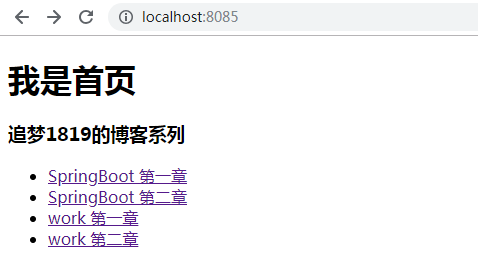
點選其中任意一個連結:

可以看到是沒有許可權訪問的。因此,上述的 security 配置成功。
第二階段:
開啟自動配置的登入功能,也就是在 SecurityConfig 配置類中加入以下程式碼:
http.formLogin();該功能的作用是,進入首頁後,點選選單,如果沒有許可權,則跳轉到登入頁。
第三階段:
下面闡述設定登入賬號和密碼。
在 SecurityConfig 配置類重寫 configure(AuthenticationManagerBuilder auth) 方法:
// 定義認證規則
@Override
protected void configure(AuthenticationManagerBuilder auth) throws Exception {
auth.inMemoryAuthentication()
.withUser("admin").password("123456").roles("admin", "test")
.and().withUser("test").password("123456").roles("test");
}注意,此處會有一個問題。如以上地址認證規則,在使用配置的賬號登入時會報錯:

這是由於在 Spring Security5.0 版本後,新增了加密方式,改變了密碼的格式。
在官網中有描述:
The general format for a password is:
Such that `id` is an identifier used to look up which `PasswordEncoder` should be used and `encodedPassword` is the original encoded password for the selected `PasswordEncoder`. The `id` must be at the beginning of the password, start with `{` and end with `}`. If the `id` cannot be found, the `id` will be null. For example, the following might be a list of passwords encoded using different `id`. All of the original passwords are "password".{bcrypt}$2a\(10\)dXJ3SW6G7P50lGmMkkmwe.20cQQubK3.HZWzG3YB1tlRy.fqvM/BG 1
{noop}password 2
{pbkdf2}5d923b44a6d129f3ddf3e3c8d29412723dcbde72445e8ef6bf3b508fbf17fa4ed4d6b99ca763d8dc 3
{scrypt}$e0801\(8bWJaSu2IKSn9Z9kM+TPXfOc/9bdYSrN1oD9qfVThWEwdRTnO7re7Ei+fUZRJ68k9lTyuTeUp4of4g24hHnazw==\)OAOec05+bXxvuu/1qZ6NUR+xQYvYv7BeL1QxwRpY5Pc= 4
{sha256}97cde38028ad898ebc02e690819fa220e88c62e0699403e94fff291cfffaf8410849f27605abcbc0 5
```
1 The first password would have a PasswordEncoderid ofbcryptand encodedPassword of$2a$10$dXJ3SW6G7P50lGmMkkmwe.20cQQubK3.HZWzG3YB1tlRy.fqvM/BG. When matching it would delegate toBCryptPasswordEncoder2 The second password would have a PasswordEncoderid ofnoopand encodedPassword ofpassword. When matching it would delegate toNoOpPasswordEncoder3 The third password would have a PasswordEncoderid ofpbkdf2and encodedPassword of5d923b44a6d129f3ddf3e3c8d29412723dcbde72445e8ef6bf3b508fbf17fa4ed4d6b99ca763d8dc. When matching it would delegate toPbkdf2PasswordEncoder4 The fourth password would have a PasswordEncoderid ofscryptand encodedPassword of$e0801$8bWJaSu2IKSn9Z9kM+TPXfOc/9bdYSrN1oD9qfVThWEwdRTnO7re7Ei+fUZRJ68k9lTyuTeUp4of4g24hHnazw==$OAOec05+bXxvuu/1qZ6NUR+xQYvYv7BeL1QxwRpY5Pc=When matching it would delegate toSCryptPasswordEncoder5 The final password would have a PasswordEncoderid ofsha256and encodedPassword of97cde38028ad898ebc02e690819fa220e88c62e0699403e94fff291cfffaf8410849f27605abcbc0. When matching it would delegate toStandardPasswordEncoder
上面這段話的解釋了為什麼會報錯:There is no PasswordEncoder mapped for the id "null",同時給出瞭解決方案。也就是 configure(AuthenticationManagerBuilder auth) 方法修改為:
// 定義認證規則
@Override
protected void configure(AuthenticationManagerBuilder auth) throws Exception {
auth.inMemoryAuthentication().passwordEncoder(new BCryptPasswordEncoder())
.withUser("admin").password(new BCryptPasswordEncoder().encode("123456")).roles("admin","test")
.and().passwordEncoder(new BCryptPasswordEncoder())
.withUser("test").password(new BCryptPasswordEncoder().encode("123456")).roles("test");
}修改後重啟專案,登入可正常訪問:
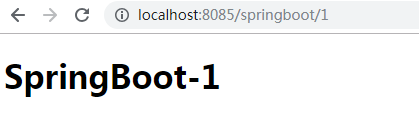
訪問結果是:賬號 admin/123456 可以訪問所有選單:SpringBoot 第一章、SpringBoot 第二章、work 第一章、work 第二章,賬號 test/123456 只能訪問 SpringBoot 第一章、SpringBoot 第二章。
第四階段:
開啟自動配置的登出功能,並清除 session,在配置類 SecurityConfig 中的 configure(HttpSecurity http) 方法中新增:
http.logout();然後在首頁 index.html 中新增一個登出按鈕:
<!DOCTYPE html>
<html lang="en" xmlns:th="http://www.thymeleaf.org">
<head>
<meta charset="UTF-8">
<title>Title</title>
</head>
<body>
<h1>我是首頁</h1>
<di>
<h3>追夢1819的部落格系列</h3>
<ul>
<li><a th:href="@{/springboot/1}">SpringBoot 第一章</a></li>
<li><a th:href="@{/springboot/2}">SpringBoot 第二章</a></li>
<li><a th:href="@{/work/1}">work 第一章</a></li>
<li><a th:href="@{/work/2}">work 第二章</a></li>
</ul>
</di>
<div>
<form method="post" th:action="@{/logout}">
<input type="submit" value="logout">
</form>
</div>
</body>
</html>啟動專案,進入首頁,點選 【logout】,會跳轉到登入介面,同時連結中帶了引數 ?logout:

當然,也可以跳轉到定製的頁面,只要將屬性修改為:
http.logout() // 退出並清除session
.logoutSuccessUrl("/");第五階段:
以上的功能基本都滿足了我們專案中的需求。不過只講述了功能點。下面我們將闡述如何在頁面展示以上功能。
首先,我們必須引入以下依賴,以便使用 sec:authentication和sec:authorize 屬性。
<dependency>
<groupId>org.thymeleaf.extras</groupId>
<artifactId>thymeleaf-extras-springsecurity4</artifactId>
</dependency>注意: 此處有版本衝突問題,以上的演示的 SpringBoot 用的版本都是 2.1.6.RELEASE。但是在此如果繼續使用該版本,則無法使用以上依賴中的 sec:authentication和sec:authorize 屬性。作者在做此演示時,對 SpringBoot 版本作了降級處理,版本為 2.1.4.RELEASE。而舊的版本有很多不同的地方,例如舊版本的登入介面是:
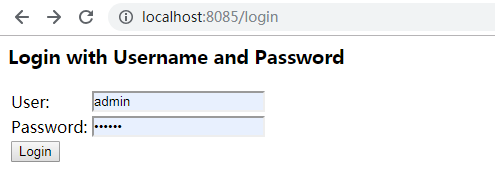
此處需要特別注意!
引入上述依賴後,我們將首頁進行改造:
<!DOCTYPE html>
<html lang="en" xmlns:th="http://www.thymeleaf.org"
xmlns:sec="https://www.thymeleaf.org/thymeleaf-extras-springsecurity4">
<head>
<meta charset="UTF-8">
<title>Title</title>
</head>
<body>
<h1>我是首頁</h1>
<!--沒有登入-->
<div sec:authorize="!isAuthenticated()">
<a th:href="@{/login}">login</a>
</div>
<!--已登入-->
<div sec:authorize="isAuthenticated()">
<div>
<form method="post" th:action="@{/logout}">
<input type="submit" value="logout">
</form>
</div>
登陸者:<span sec:authentication="name"></span>
登陸者角色:<span sec:authentication="principal.authorities"></span>
</div>
<div>
<h3>追夢1819的部落格系列</h3>
<ul>
<!-- 通過角色判斷是否展示-->
<div sec:authorize="hasRole('admin')">
<li><a th:href="@{/springboot/1}">SpringBoot 第一章</a></li>
<li><a th:href="@{/springboot/2}">SpringBoot 第二章</a></li>
</div>
<div sec:authorize="hasRole('test')">
<li><a th:href="@{/work/1}">work 第一章</a></li>
<li><a th:href="@{/work/2}">work 第二章</a></li>
</div>
</ul>
</div>
</body>
</html>啟動專案,分別用不登入、 admin/123456、test/123456 登入,檢視效果:

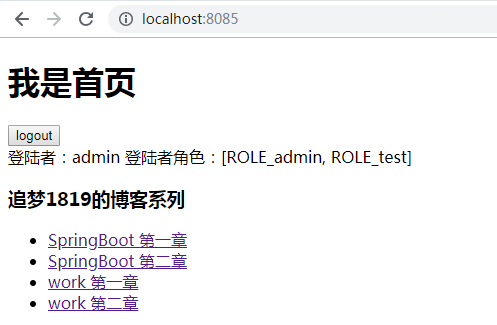
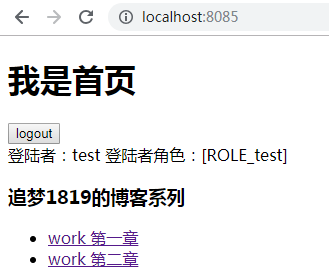
第六階段:
最後我們講解一個常用的功能,就是登陸的記住功能,配置很簡單,在配置類 SecurityConfig 中的 configure(HttpSecurity http) 方法中新增即可:
http.rememberMe() // 記住功能
.rememberMeParameter("remember") //自定義rememberMe的name值,預設remember-Me
.tokenValiditySeconds(10); // 記住時間進入登陸介面:
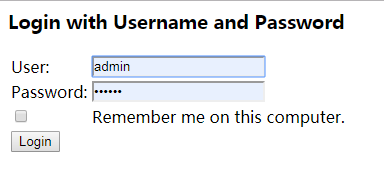
新增該方法後,登入頁會出現記住功能的複選框。
總結
還有很多詳細的功能。由於篇幅所限,本章中不做一一細解。如果想了解更多,作者給讀者的建議是,可以多看看 WebSecurityConfigurerAdapter 、HttpSecurity、AuthenticationManagerBuilder 等類的原始碼,比較簡單,很容易上手。另外就是其文件非常的詳細、清晰(文件詳細是Spring的一個特色)。可以讓大家先感受一下 Spring 原始碼文件的強大:
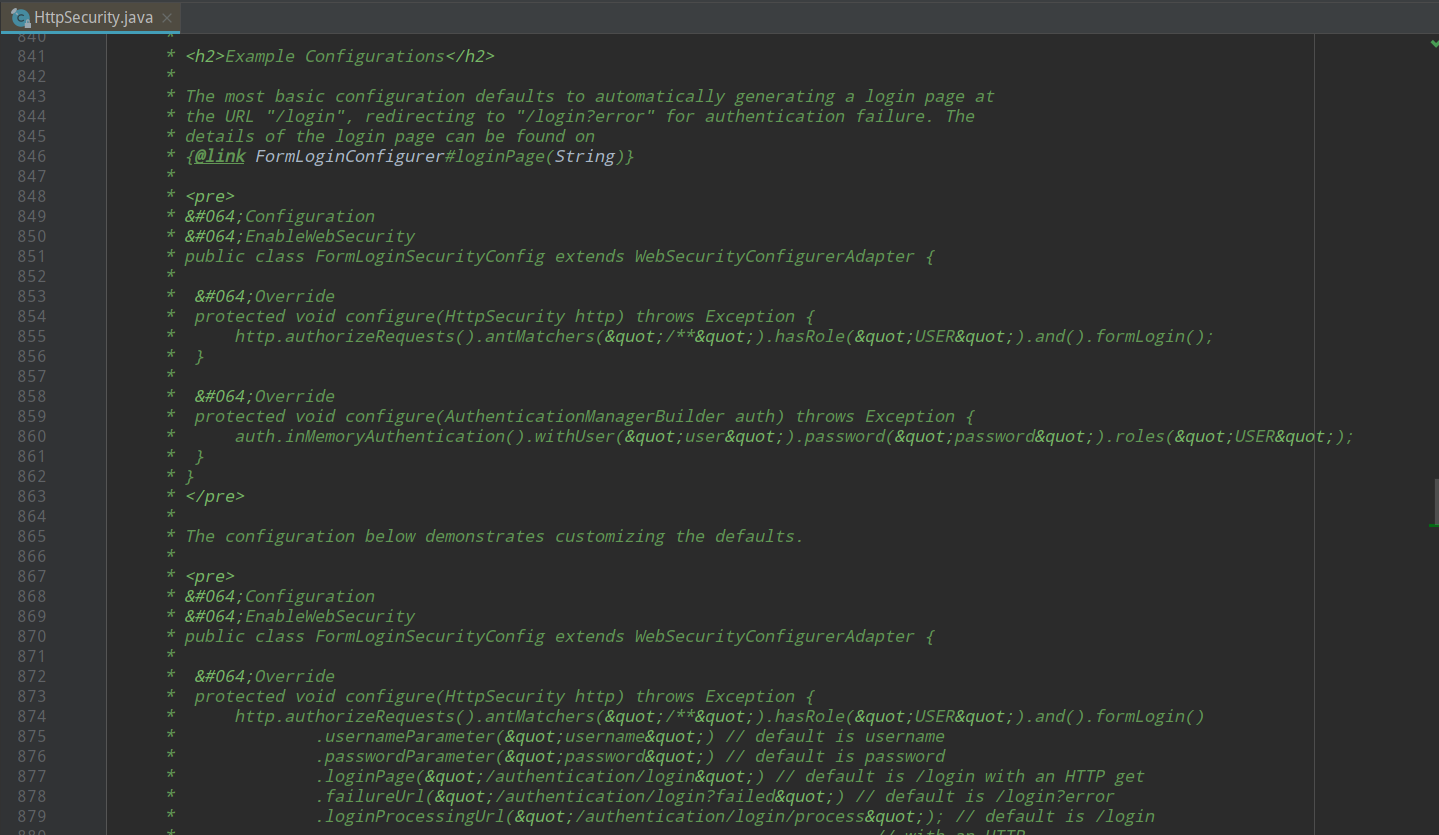
功能描述、示例一應俱全。
結語
其實對以上功能的瞭解,不算很難。但是這篇部落格前後寫了六七個小時。作者看了翻閱了不少的資料,通讀對應的官方文件,聽了一些比較好的課程,然後自己一一校驗,思考,排版,解決版本衝突等。最終是希望讓讀者能夠看到一篇準確、美觀、較詳細的資料,不至於陷入網上的亂七八糟的資料中無法自拔。
參考
- Spring Security Reference
- Hello Spring Security with Boot
WebSecurityConfigurerAdapter、HttpSecurity、AuthenticationManagerBuilder等類的原始碼

相關推薦
SpringBoot第二十三篇:安全性之Spring Security
作者:追夢1819 原文:https://www.cnblogs.com/yanfei1819/p/11350255.html 版權宣告:本文為博主原創文章,轉載請附上博文連結! 引言 系統的安全的重要性人人皆知,其也成為評判系統的重要標準。 Spring Security 是基於 Spring 的
一起來學SpringBoot | 第二十三篇:輕鬆搞定重複提交(分散式鎖)
SpringBoot 是為了簡化 Spring 應用的建立、執行、除錯、部署等一系列問題而誕生的產物,自動裝配的特性讓我們可以更好的關注業務本身而不是外部的XML配置,我們只需遵循規範,引入相關的依賴就可以輕易的搭建出一個 WEB 工程 在 一起來學S
轉載:SpringBoot非官方教程 | 第二十三篇: 非同步方法
轉載:https://blog.csdn.net/forezp/article/details/71024169 這篇文章主要介紹在springboot 使用非同步方法,去請求github api. 建立工程 在pom檔案引入相關依賴: <dependency
一起來學SpringBoot | 第十三篇:RabbitMQ延遲佇列
SpringBoot 是為了簡化 Spring 應用的建立、執行、除錯、部署等一系列問題而誕生的產物,自動裝配的特性讓我們可以更好的關注業務本身而不是外部的XML配置,我們只需遵循規範,引入相關的依賴就可以輕易的搭建出一個 WEB 工程 初探Rabbi
SpringBoot第十三篇:日誌處理
作者:追夢1819 原文:https://www.cnblogs.com/yanfei1819/p/10973583.html 版權宣告:本文為博主原創文章,轉載請附上博文連結! 引言 日誌是軟體系統的“基礎設施”,它可以幫助我們瞭解系統的執行軌跡,查詢系統的執行異常等。很多人都沒有引起對日誌的重視。
第十三篇:Spring Boot之郵件服務
傳送郵件應該是網站的必備功能之一,什麼註冊驗證,忘記密碼或者是給使用者傳送營銷資訊。最早期的時候我們會使用JavaMail的相關API來編寫傳送郵件的相關程式碼,後來Spring推出了JavaMailSender更加簡化了郵件傳送的過程,再之後Spring Boot對此進行了封裝就有了現
SpringBoot非官方教程 | 第十三篇:springboot整合spring cache
本文介紹如何在springboot中使用預設的spring cache, 宣告式快取 Spring 定義 CacheManager 和 Cache 介面用來統一不同的快取技術。例如 JCache、 EhCache、 Hazelcast、 Guava、 Redi
“全棧2019”Java第二十三章:流程控制語句中決策語句switch上篇
難度 初級 學習時間 10分鐘 適合人群 零基礎 開發語言 Java 開發環境 JDK v11 IntelliJ IDEA v2018.3 文章原文連結 “全棧2019”Java第二十三章:流程控制語句中決策語句switch上篇 下一章 “全棧2019”Java第二十四
第二篇:SpringCloud之服務消費(Ribbon)
在微服務架構中,業務都會被拆分成一個獨立的服務,服務與服務的通訊是基於Http RESTful的。SpringCloud有兩種服務呼叫方式,一種是Ribbon+RESTTemplate,另一種是Feign。在這一篇文章首先講解下基於Ribbon+REST。 Ribbon簡介
敏捷結果30天之第二十三天:執行中的專注
時間管理的最終目的是高效的把事情做成並且要做好。有目標,有計劃,按照計劃去執行。執行的過程會遇到就會遇到拖延,我們就需要在執行過程中專注,只要專注後執行力和效率才能提高。 對於個人管理而言: 1.要有階段型目標,並且要制訂一個執行計劃 2.有執行計劃
Python之路【第二十三篇】爬蟲
difference between urllib and urllib2 自己翻譯的裝逼必備 What is the difference between urllib and urllib2 modules of Python? #python的urllib2
一起來學SpringBoot | 第十五篇:actuator與spring-boot-admin 可以說的祕密
SpringBoot 是為了簡化 Spring 應用的建立、執行、除錯、部署等一系列問題而誕生的產物,自動裝配的特性讓我們可以更好的關注業務本身而不是外部的XML配置,我們只需遵循規範,引入相關的依賴就可以輕易的搭建出一個 WEB 工程 一起來學Spr
第二十三章:SpringBoot專案多模組打包與部署
我們接上章節內容繼續,上一章我們已經完成了多模組專案的建立以及執行,那我們線上環境該如何打包部署呢? 本章目標 打包部署SpringBoot多模組專案到外部執行Tomcat容器中。 構建專案 我們直接複製一份上一章的程式碼,如下圖1所示:
SpringBoot第九篇:整合Spring Data JPA
作者:追夢1819 原文:https://www.cnblogs.com/yanfei1819/p/10910059.html 版權宣告:本文為博主原創文章,轉載請附上博文連結! 前言 前面幾章,我們介紹了 JDBCTemplate、MyBatis 等 ORM 框架。下面我們來介紹極簡模式的 Sprin
跟我學SpringCloud | 第十三篇:Spring Cloud Gateway服務化和過濾器
SpringCloud系列教程 | 第十三篇:Spring Cloud Gateway服務化和過濾器 Springboot: 2.1.6.RELEASE SpringCloud: Greenwich.SR1 如無特殊說明,本系列教程全採用以上版本 上一篇文章服務閘道器 Spring Cloud G
第二十三篇 jQuery 學習5 添加元素
展示 頁面 script 興趣 提示 什麽 urn round wid jQuery 學習5 添加元素 同學們,這節課,使用jQuery動態添加元素,是很關鍵的一課,一般用在什麽地方呢:別人發表一篇文章,你評論樓主的時候,總不能是提交表單,到後臺的其他頁面處理,然後再刷
第十五篇:JavaScript 之 Dom操作
頁面 對象模型 面向 方法 bsp log gpo eva div 一、後臺管理頁面布局 二、JavaScript函數 三、eval以及時間操作 四、JavaScript作用域 五、JavaScript面向對象模型 六、DOM選擇器 七、DOM事件操作 八、DOM綁定事件的
python全棧開發基礎【第二十三篇】線程
不同 控制 上海 strong 執行 不能 子進程 申請 什麽 一、什麽是線程 線程:顧名思義,就是一條流水線工作的過程,一條流水線必須屬於一個車間,一個車間的工作過程是一個進程 所以,進程只是用來把資源集中到一起(進程只是一個資源單位,或者說資源集合),而線程才是cpu上
Django 【第二十三篇】優化查詢
所有 一次 inf app related 方式 del filter model 一、假設有三張表 Room id 1 2 .. 1000 User: id 1 .. 10000
第二十三篇 logging模塊(******)
closed out 原因 fin bubuko struct ace 更多 mon 日誌非常重要,而且非常常用,可以通過logging模塊實現。 熱身運動 import logging logging.debug("debug message") logging.i
